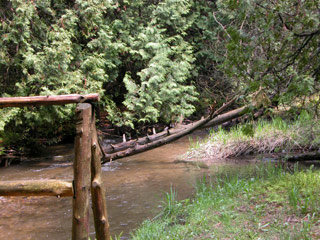Water Source—Activity Sheet
Where does water come from?
Your drinking water may come from rivers, lakes, streams, ponds, reservoirs, springs, and wells. As the water travels over the surface of the land or through the ground, it dissolves naturally occurring minerals and can pick up substances resulting from the presence of animals or from human activity.
So what's in our water?
Drinking water may reasonably be expected to contain at least small amounts of contaminants. The presence of contaminants does not necessarily indicate that water poses a health risk. Contaminants that may be present in source water include microbial contaminants (such as viruses and bacteria), pesticides and herbicides, or chemical contaminants.
What is a watershed? The land area that water moves across or under while flowing to a stream, spring, pond, lake, or river is called the watershed. Prior to human intervention and use, watersheds tended to be in natural balance with the ecological components of the environment. The rivers that give it its form are engaged in the gradual erosion and wearing down of the highlands that contain it.
The land area that water moves across or under while flowing to a stream, spring, pond, lake, or river is called the watershed. Prior to human intervention and use, watersheds tended to be in natural balance with the ecological components of the environment. The rivers that give it its form are engaged in the gradual erosion and wearing down of the highlands that contain it.
How do we impact our watershed?
Human settlement began to affect the gradual rate at which watersheds erode and other conditions within watersheds through actions such as land clearing, dam building, farming, and industrial development.
Human use of waters in a watershed usually takes the form of diversion of water from the natural flow of streams, ponds, rivers, and lakes. The growth of human populations in the area of a watershed may result in an escalating diversion. As an example, the need for water and hydroelectric power often motivates the building of dams. Dams may radically alter stream habitats, yet they do not necessarily provide predictable water supplies for agriculture, domestic uses, and industry.
Although contamination of watersheds is a serious problem for humans, it is a greater problem for wildlife. Most often it is wildlife and in particular aquatic wildlife that suffers the most directly and immediately from contamination. Natural food chains can be damaged for decades by a single contamination.
he most important thing to remember about watersheds is that they are not single units, connected to other watersheds as they are traced downstream. What affects a watershed in one place eventually affects other sites downstream. Most scientists feel it is far more economical to prevent contaminants from entering water systems than to clean up pollution after it takes place. There are obviously trade-offs to consider in decisions affecting watersheds.
To assess the health of your watershed:
1. Gather maps, supplies, and other resources.
2. Locate your school on the watershed maps. Which watershed do you live in?
3. Identify potential impacts that might affect the health of the watershed.
4. Please obey safety, environment, and landownership rules when collecting samples.
5. Try the watershed investigations!
This content has been re-published with permission from SEED. Copyright © 2025 Schlumberger Excellence in Education Development (SEED), Inc.

